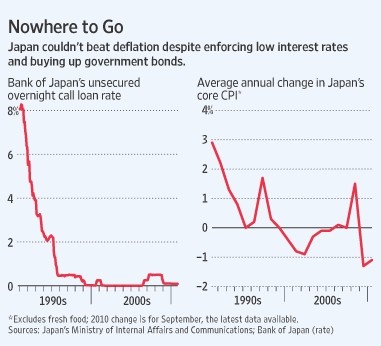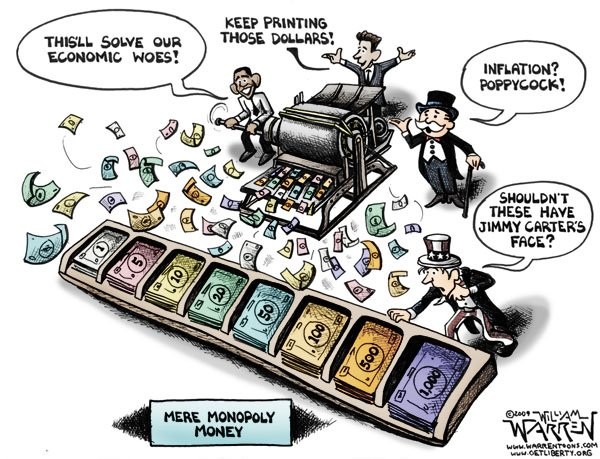Why ‘Quantitative Easing’ Hasn’t Led to High Inflation
Post on: 30 Август, 2015 No Comment

Since the financial crisis began in August 2007, one of the puzzles surrounding the Federal Reserve’s quantitative easing program—i.e. money printing—has been why it has not led to high levels of consumer price inflation in areas other than food and energy.
In the past five years, the Consumer Price Index (CPI) minus food and energy has increased by an average annual rate of 0.96 percent, even though the Federal Reserve has expanded its balance sheet by roughly $1.9 trillion since the crisis started at an annual rate of $469.7 billion.
Economist Milton Friedman once defined inflation as “too many dollars chasing after too few goods.” So, why has consumer goods and services inflation been low despite tremendous increases in the monetary base?
Also, why have prices risen in food, energy, and other commodities during the same period? Food prices have increased at an average yearly rate of about 2.8 percent since August 2007, and energy prices by about 5.1 percent.
Balance of Payments Effects
The answer lies in the balance of payments deficit the United States runs. This is the amount of capital flowing out of the country as measured by the Bureau of Economic Analysis. The measure includes the trade deficit, interest paid to foreigners on the national debt, and other items. The payments deficit has averaged $491.7 billion the past four years.
It is no coincidence, then, that Federal Reserve Chairman Ben Bernanke intends to engage in further quantitative easing—purchasing approximately $480 billion of mortgage-backed securities a year. This will offset the balance of payments deficit.
With the domestic supply of money being relatively stable, prices of consumer goods and services have remained steady. But because commodities are priced and traded globally with the dollar—the world’s reserve currency—food, energy, gold, and other commodity prices have been highly susceptible to the expansion of the dollar supply worldwide.
For that reason, quantitative easing has the side effect of actually worsening the balance of payments deficit, particularly on the heels of higher oil prices. So, the more Bernanke does it, the worse it will get.
Credit Expansion Offsets
But why wasn’t massive quantitative easing necessary before the financial crisis? We have been running balance of payments deficits totaling hundreds of billions of dollars for years, while the Fed’s balance sheet was relatively stable prior to the recession.
The answer is that before the crisis, the primary mechanism for expanding the supply of dollars was not Fed quantitative easing programs; it was credit expansion by financial institutions. Because banks hold far less capital compared to the credit they issue, money is essentially lent into existence.
For decades, credit expansion in the United States offset these balance of payments deficits with the total amount of debt outstanding nationwide practically doubling every decade. But this was unsustainable. The American consumer cannot indefinitely live off of ever-larger sums of credit.
In addition, high default rates have led to a credit contraction since 2008. Now, credit outstanding is more or less frozen at $55 trillion, having grown by only $1.2 trillion since then at an annual pace of just $300 billion. That implies that bank capital is expanding by about $30 billion a year right now.
To stay on the doubling trend, credit would need to grow by about $5 trillion every year, with an implied capital expansion of $500 billion by banks.

We’re nowhere near that now. So, Bernanke’s latest program to give $480 billion a year to banks was entirely predictable. One should expect the Fed’s money printing to continue indefinitely until credit expansion forces reassert themselves—if ever.
In the meantime, we should not necessarily expect Weimar-style hyperinflation on the heels of the Fed’s monetary expansion. As long as the dollar remains the world’s reserve currency, our balance of payments deficit will continue to fulfill demand for dollars overseas.
But if our creditors overseas, such as China or Saudi Arabia, were to ever drop the dollar or dump U.S. Treasuries, then all of the surplus dollars would flow back home again. A run on dollar-denominated assets would ensue, hyperinflation would take hold, and the country would face a catastrophic default on its obligations.
For that reason, Bernanke is running a supreme risk by continuing to export dollar inflation overseas. This is already leading to higher prices overseas, which is economically and politically destabilizing regions such as the Middle East and North Africa. The overthrow of the governments of Tunisia and Egypt began as food riots.
Social Upheaval
Even with the best intentions regarding the domestic U.S. economy, it is immoral to continue to wreak societal upheaval across the developing world through currency debasement. In addition, it creates a huge disincentive to continue trading in dollars, risking the nation’s status as the world’s preeminent economic power.
Hence, although solutions like a return to sound, value-based money may be painful in the short term, they will provide an honorable way out this mess. The Fed’s current course risks a disorderly breakdown of the global financial system, economic and political destabilization, and depression.
Robert Romano (robert@getliberty.org ) is the senior editor of Americans for Limited Government.














